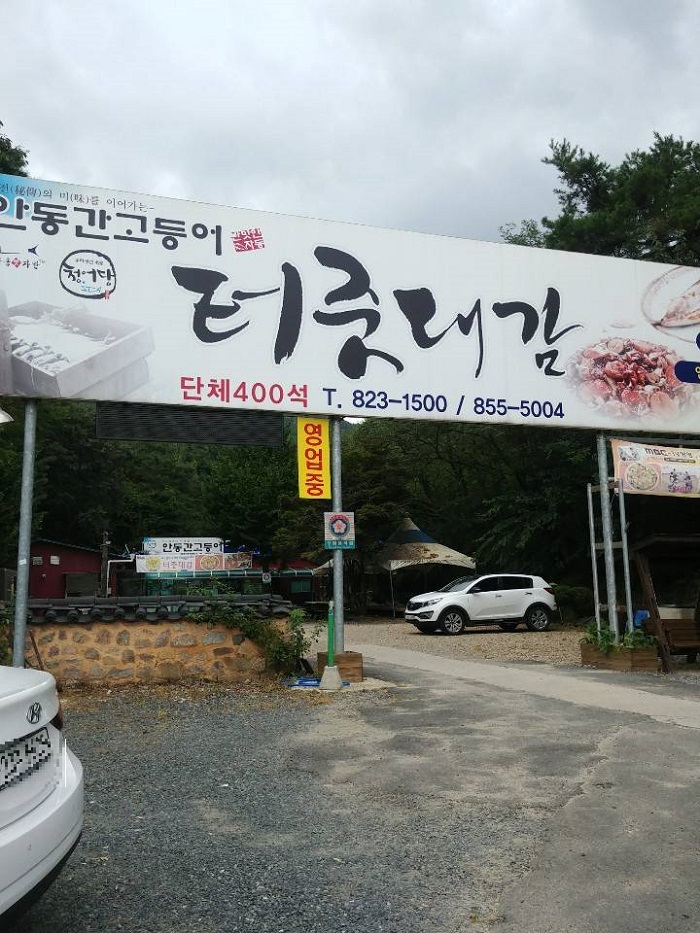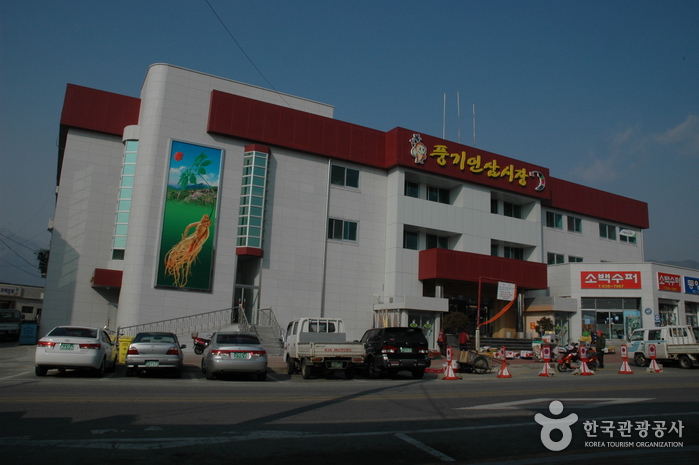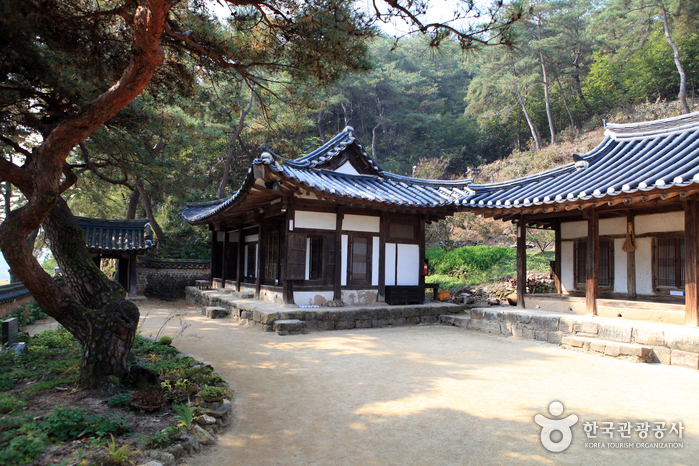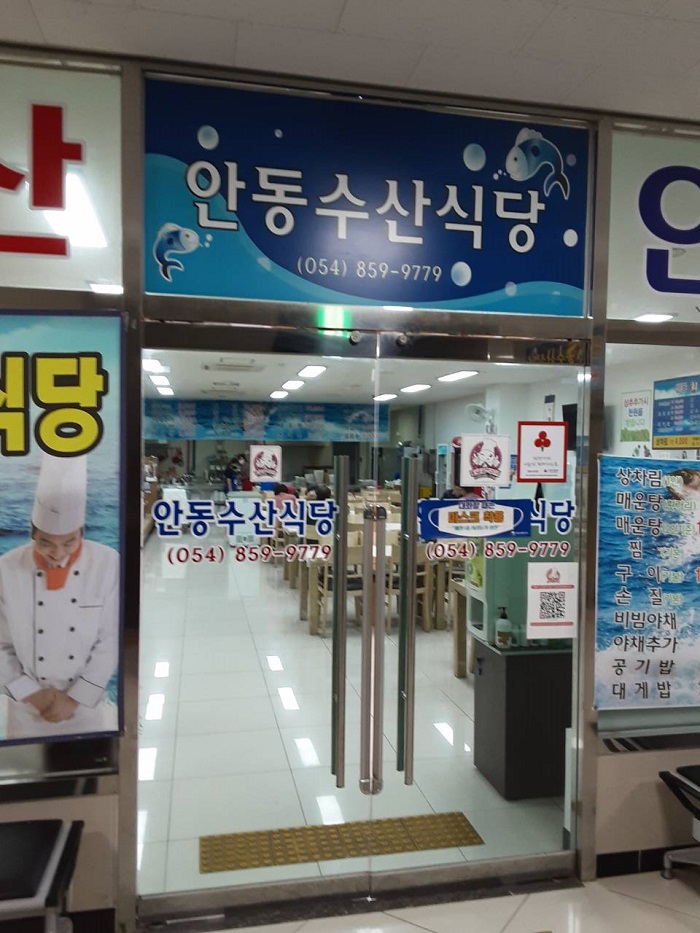Andong Gangodeungeo Teojutdaegam (안동간고등어터줏대감)
19.6 Km 0 2021-03-24
217, Jeonseo-ro, Andong-si, Gyeongsangbuk-do
+82-54-823-1500
This is a place where you can enjoy Andong Jjimdak, the representative dish of Andong. This restaurant's signature menu is andong braised chicken. This Korean dishes restaurant is located in Andong-si, Gyeongsangbuk-do.
Marché de Ginseng de Punggi (풍기인삼시장)
19.7 Km 11156 2021-05-17
8, Insam-ro, Yeongju-si, Gyeongsangbuk-do
+82-54-633-7948
Le marché de ginseng de Punggi, le plus ancien dans la région de Punggi, est creonnu pour sa gamme de produits à base de ginseng. Tous les 3ème et 8ème jours du mois, un marché traditionnel (se rendant dans plusieurs villes dans la région) ouvre ses portes près du marché de ginseng durant 5 jours, donnant au lieu une atmosphère traditionnelle et nostalgique.
Maison Ogyeonjeongsa (하회옥연정사)
19.7 Km 4658 2017-05-24
86, Gwangdeoksolbat-gil, Pungcheon-myeon, Andong-si, Gyeongsangbuk-do
La Maison Ogyeonjeongsa, située au pied de la falaise Buyongdae dans le village de Hahoe à Andong, a été construite par Ryu Seong-yong, qui fut ministre durant la période Joseon. Sa construction a débuté en 1576 (9ème année du règne du roi Seonjo) et s’est achevée en 1586 (19ème année du règne du roi Seonjo). C’est dans cette maison que furent écrites les mémoires de guerre « Jingbirok » après l’Imjinwaeran, l’invasion de la Corée par le Japon en 1592. Pour vous rendre à la maison Ogyeonjeongsa, il vous faut traverser la rivière en ferry. En dépit de l’apparence modeste de la demeure, la beauté sans prétention de cette maison coréenne se fond parfaitement dans le magnifique cadre naturel des falaises, de la rivière et de la forêt.
* Ecole Sesimjae
Cette école privée est dotée en son centre d’un plancher en bois Gamrokheon, flanqué de chambres de chaque côté.
* Maison Wolnakjae
Wolnakjae signfie « attendre un ami ». C’est dans cette maison que le ministre Ryu Seong-yong a écrit ses mémoires de guerre Jingbirok.
* Centre d’activités
Sesimjae (deux chambres de quatre personnes maximum chacune, plancher en bois Gamrokheon)
Wolnakjae (une chambre pour huit personnes maximum, plancher en bois Aeoheon)
Okyeon pavilion [Korea Quality] / 옥연정사 [한국관광 품질인증]
19.7 Km 13101 2023-04-13
86, Gwangdeoksolbat-gil Pungcheon-myeon, Andong-si, Gyeongsangbuk-do
+82-54-854-2202 / +82-10-4520-3640
Ogyeonjeongsa House was established by Ryu Seong-yong (pen-name: Seoae, 1542-1607), a minister of Joseon, with the help of Buddhist monk Tanhong, as a place to study and educate his students. After building Wonjijeongsa House, Ryu wanted to build another house at the foot of Buyongdae Cliff amid a tranquil environment away from the village, but due to his financial situation he was unable to complete the building by himself. Then, the monk Tanhong helped him build Ogyeonjeongsa House, which took ten years (1576 to 1586) to complete, when Ryu was 45 years old. Later, Ryu Seong-yong was able to share warmth with his brother (Gyeomam), who lived in nearby Gyeomamjeongsa House. Ryu later lost his house in Hahoe in the great flood of the Nakdonggang River in 1605, and retired to Ogyeongjeongsa House where he wrote Jingbirok (The Book of Correction, National Treasure 132), a memoir of the Imjin War (Japanese Invasion of Korea in 1592). The house’s guestrooms include Sesimjae (meaning ‘having a mind to this place to achieve at least one in ten thousand things,’ inspired by the I Ching or The Book of Changes), which was used by Ryu as a schoolhouse and has two small rooms between the maru gamheonrok (wooden floor, meaning ‘looking up at the sky and down at the blue water,’ inspired by Wang Xizhi’s poetic diction); Wonlakjae (meaning ‘waiting for a friend’s visit,’ inspired by the Analects of Confucius), in which Ryu himself resided and wrote Jingbirok; and the maru aeoheon (meaning ‘I also love my hut,’ taken from a poem by Chinese poet Tao Yuanming), which measures two kan (a unit of measurement referring to the distance between two columns).
Yangjindang [Korea Quality] / 하회 양진당 [한국관광 품질인증]
19.8 Km 263 2020-09-02
68, Hahoejongga-gil, Andong-si, Gyeongsangbuk-do
+82-10-4113-8760
“Andonog Hahoe Yangjindang,” located in the Hahoe Folk Village, is Treasure No 306 and the residence of a family with the surname Pungsan Ryu. A tablet read Ipam Antique House, named after Ipam Ryu Jung Yeong (1515 - 1573), is hung on the entrance. Yangjindang is named after the nickname of Ryu Yeong (1687 - 1761), the sixth generation of Gyeongam Ryu Un Ryong, son of Ipam. The name means “nourishing well one's own nature.” The Hanok stands over the entrance, with a well-polished floor that is grand yet friendly. One of the characteristics of the house is that it includes Sarangcha or detached building, which reflects the architecture from the Goryeo period, and Anchae or main building in the architecture style from the Joseon period.
It is expected that such co-existence was made possible because of the repairs done after Imjin War. How fortiunate that the antique house has been preserved until now! The well-tended garden shows the commitment of the descendants to maintaining the space. Rooms are rather simple compared to the grand exterior of the house. Traditional mother-of-pearl furniture, tableware in the cupboard, randomly ceramics placed draw attention. The house resembles a small folk museum. Why not enjoy some traditional folk games during your stay? There is a variety of play tools such as yut, tuho, jegi, tops, and kites. Experience programs such as gayangju brewing, rice cake and traditional dessert making, and flower tea are conducted by the first daughter-in-law of the house, depending on the season.
Andong Susan Sikdang (안동수산식당)
19.9 Km 61 2021-03-24
64, Yutongdanji-gil, Andong-si, Gyeongsangbuk-do
+82-54-859-9779
It is a store where you can enjoy fresh seafood. This Korean dishes restaurant is located in Andong-si, Gyeongsangbuk-do. The representative menu is cold raw fish soup.
Ga Gyeong Jae [Korea Quality] / 가경재 [한국관광 품질인증]
19.9 Km 6577 2023-04-13
69-5, Hahoenamchon-gil, Andong-si, Gyeongsangbuk-do
+82-54-855-8552
Gagyeongjae, or House with a Beautiful View, is a place with a thatched roof and an unhindered view. Guests can enjoy the view of natural environment over the window, with cool breeze freely flowing in the rooms. There are five rooms in total including Anchae Sangbang, Sarangchae Upper Room and Lower Room, Ondol Red Clay Lower Room, and Door Room. Guests in Anchae can use the central porch, whereas guests in Sarangchae can take advantage of the central floor as well. Ondol Red Clay Room is popular; it is heated by the owner himself through the traditional fireplace outside the room. The room, however, requires reservation at least 2 days in advance.
Air conditioners were recently installed in the hanok. Additional fees are separately charged in summer, but it is just great to enjoy air conditioning in a hanok. Note that reservation and inquiry over the phone is faster and more convenient than that on the website. There are many restaurants and places to experience in Hahoe Folk Village. It is a nice place to enjoy many things and just relax.
RakKoJae Andong(Hahoe) [Korea Quality] / 락고재 안동(하회) [한국관광 품질인증]
20.0 Km 19085 2023-04-13
51, Hahoegangbyeon-gil, Pungcheon-myeon, Andong-si, Gyeongsangbuk-do
+82-54-857-3410
Rakkojae, meaning “a place where one can enjoy ancient traditions and rest one’s soul”, is located near the beautiful ferry on the Nakdonggang River in Hahoe, Andong. After passing by a pine tree decorated with traditional Korean lanterns and entering the cozy courtyard, visitors will find four well-maintained houses with thatched-roofs made with local rice straw. As Rakkojae is some way from the Hahoe Village, and is adjacent to the Nakdonggang River, guests can enjoy walking along the ferry and the walkway while appreciating the beautiful scenery of the river and Buyongdae Cliff with its serene atmosphere. Rakkojae has three guest accommodations – the anchae at the front, the sarangchae and the byeolchae on the sides, and the munganchae. While the anchae has two rooms, a kitchen and a daecheong (main floored room), both the sarangchae and the byeolchae consist of a daecheong and one room. The maximum number of guests per room is ten so that guests can enjoy their stay with ease. Each room is decorated with hanji (traditional Korean paper handmade from mulberry trees) and features a simple built-in closet, ceiling-type air conditioning, and a modern bathroom with a toilet and a bathtub made of Hinoki cypress. In particular, the munganchae has a red clay jjimjilbang (Korean dry sauna) supplied with mugwort that is popular among both domestic and foreign guests. Guests often enjoy relaxing at Rakkojae by appreciating the sunshine and breeze while lying on the daecheong floor, walking barefoot on the earthen ground, and drinking makgeolli (unrefined rice wine)among other activities. The owners of Rakkojae hope that it will be a place where guests can heal their tired body and mind and experience the true atmosphere of Korea. The Pine Wood of Mansongjeong Pavilion (Natural Monument No. 473) situated next to Rakkojae is also a good place for a stroll. Furthermore, the hotel serves a hearty breakfast consisting of heotjesatbap (Andong-style bibimbap with soy sauce) and salted grilled mackerel.



![Okyeon pavilion [Korea Quality] / 옥연정사 [한국관광 품질인증]](http://tong.visitkorea.or.kr/cms/resource/50/2578050_image2_1.jpg)
![Yangjindang [Korea Quality] / 하회 양진당 [한국관광 품질인증]](http://tong.visitkorea.or.kr/cms/resource/81/2626381_image2_1.jpg)

![Ga Gyeong Jae [Korea Quality] / 가경재 [한국관광 품질인증]](http://tong.visitkorea.or.kr/cms/resource/00/2626200_image2_1.jpg)
![RakKoJae Andong(Hahoe) [Korea Quality] / 락고재 안동(하회) [한국관광 품질인증]](http://tong.visitkorea.or.kr/cms/resource/84/2573784_image2_1.jpg)
 Français
Français
 한국어
한국어 English
English 日本語
日本語 中文(简体)
中文(简体) Deutsch
Deutsch Español
Español Русский
Русский